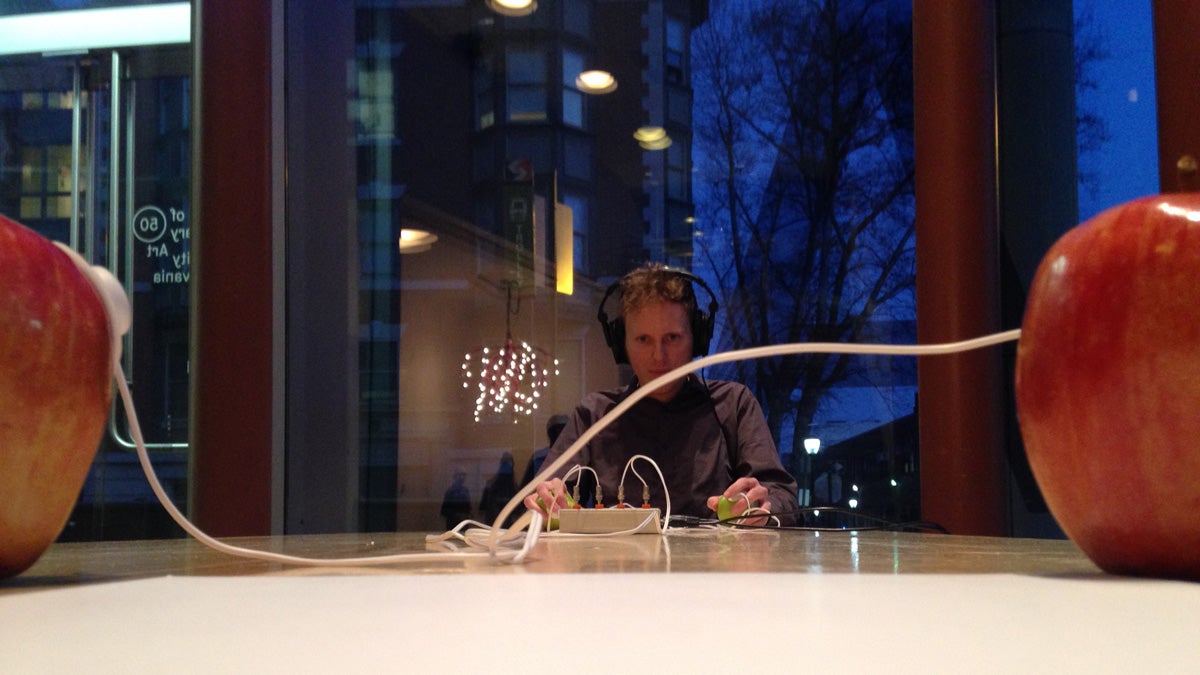Setting human biorhythms to an electronic beat: Data Garden
Listen
Data Garden co-founder Joe Patitucci using one of his record label's creations. (Charlie Kaier/WHYY)
Generating music through your own electrical currents … and some apples.
Pulse audio engineer Charlie Kaier is holding a gray box, about the size of a brick.
It belongs to Joe Patitucci, a co-founder of Data Garden, which is a Philly-based record label and arts organization that lives right at the intersection of music and science.
“What this does, is it actually translates biorhythms from plants or from humans into data that can be played with a synthesizer or through a computer,” Patitucci said.
What that means, is that the natural, electrical currents pulsing through Charlie’s palms have become a temporary soundtrack. Using the sensors you’d see on a lie detector, Data Garden can measure changes in what’s called skin conductance and have each frequency play a corresponding sound.
“A plant or a human can play any note on a scale that we choose to allow it to,” Patitucci explained.
The gray box is a prototype of a gizmo called the “MIDI Sprout” that Data Garden wants to mass-produce. Patitucci says a crowdfunding campaign (and an appearance at South by Southwest) is coming next month in a bid to get more people making — micro-genre alert — biofeedback music.
“It’s not about ego,” Patitucci said of making music with biorhythms. “It’s more about an exploration of your own body or different forces in the universe.”
Biorhythms on display
Last Wednesday, the MIDI Sprout was one of several interactive installations on display at a Data Garden event put on by the Institute of Contemporary Art (ICA) at the University of Pennsylvania.
Another was a pair of apples wired to a computer, some headphones and a subwoofer attached to a chair.
“By grabbing these two apples you’re completing a circuit, and the changes in your conductivity are generating music,” Patitucci said. “When you sit down and you actually experience this, you can close your eyes and it just kind of feels like you’re leaving earth.”
“It’s interesting because both the analog and the digital here play an equally important role,” said Grace Ambrose, an ICA curator who organized the event.
The museum is in its 50th-anniversary season. The Data Garden “micro exhibition” is one of about 50 ICA is putting on this year. Ambrose says the cool thing about this installation was the tangible interplay of the human and the non-human — electrical currents from the body becoming blips and beats.
“There’s definitely complicated technology involved,” she said, “but it’s also an interesting way for people to look at things that are being made and figure that it’s something they could also do themselves.”
The event drew a packed house of about 300, Ambrose said.
It also doubled as a record release party for musician Greg Fox. For his new album, Fox worked with Milford Graves, a jazz drummer and holistic healer based in Queens, N.Y., who has built technologies for transforming human biorhythms into MIDI, the language of electronic instruments.
“We made high quality recordings of my heartbeat,” said Fox, “and then used software that [Graves] developed with another person to translate that information in a MIDI score, a very rich MIDI score, bringing all the sub-frequencies up out of it, so that the pitch and the melody of the heartbeat can be heard.”
It’s there, below, a heartbeat speaking through machines.
WHYY is your source for fact-based, in-depth journalism and information. As a nonprofit organization, we rely on financial support from readers like you. Please give today.




